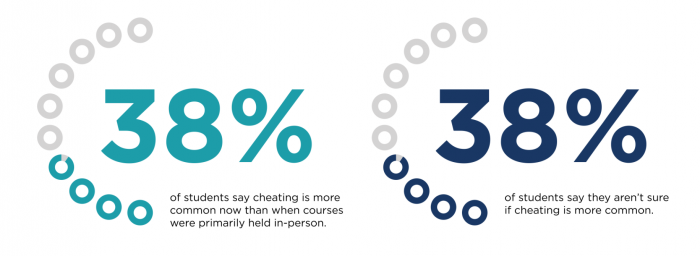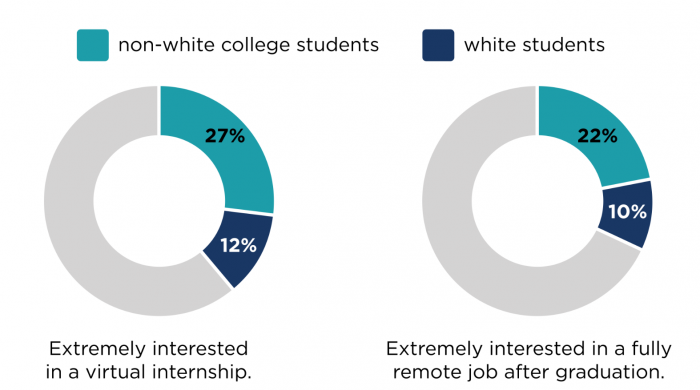
While your campus is experiencing its own interesting changes and challenges as the fall semester kicks off, we tracked some trends for the upcoming academic year in an effort to put the spotlight on a few things you may see over the coming months – and quite possibly beyond that.
A variety of learning options offered. While most students want to return to in-school learning, a survey of college students finds a majority also want options. To meet this demand and maintain enrollment, schools will continue to be forced to offer programs that are fully online and hybrid learning. When students were asked what they’d like to see continue after the pandemic, the top answer (79%) was keeping lectures video-recorded and available online, even for in-person courses.
Investment in the virtual infrastructure. The need for improved virtual instruction, technology to track online course interactions and reduce cheating in online courses, and a full array of virtual student services will force a redirection of resources from the physical infrastructure on campuses to virtual technology and support.

A return to a more traditional academic calendar. With vaccines in play, more colleges plan to return to the traditional academic calendar this year. That being said, school calendars are also becoming more fluid in general, with flexible online and hybrid courses that allow students to catch up on missed courses and accelerate their program completion.
Being held accountable for diversity, equity, and inclusion. Institutions are increasingly being held accountable for meeting metrics that reflect diversity, equity, and inclusion in student populations and in faculty and staff hiring priorities.
Price takes on new meaning. Schools are now competing to launch lower-cost online degrees to serve the demand for value-oriented students. Elite colleges and universities that don’t serve poor or diverse students will lose the luster they’ve had. Institutions that are student-centric and innovative, and that find non-traditional ways to freeze and lower costs, will be the new role models.
More non-degree education and non-traditional degrees. Employers are driving a movement that supports non-degree education and certificates. Google and more than 130 other companies are treating Google tech certificates as equivalent to a degree. More employers are also supporting education as a benefit, increasing the number of non-traditional students and expanding use of online-only programs.
More virtual internships and jobs. Employers will have the opportunity to recruit more diverse candidates – from a plentiful pool of applicants. A college student survey as part of Inside Higher Ed’s Student Voice initiative found that non-white college students are more than twice as likely to desire a virtual internship compared to white students. Similarly, they’re also more than twice as likely to be extremely interested in taking a fully remote job after graduation.

Flexibility to work at home continues. As with other employers, many institutions will continue to offer faculty and staff options for virtual work.
Focus on meeting student counseling needs. Student counseling needs have multiplied and intensified as new stress has impacted the students and families your college serves – from changes in the way we live, work, and go to school to illness, death, and economic pressure. Mental health issues, along with housing and food insecurity, are very real concerns on virtually every campus.
Financial aid negotiations may be more flexible. Students may get more financial aid based on economic situations impacted by the financial fallout of COVID-19. Federal student loan flexibility due to the COVID-19 emergency has been extended through January 31, 2022 with experts saying it’s unlikely another extension will follow.
More schools requiring vaccination. Prior to Pfizer’s vaccine receiving FDA approval, the Chronicle of Higher Education reported that about 600 institutions required students to be vaccinated before returning to campus. Since then, even more have joined the ranks. Individual states vary, but college policies will continue to change, with lawsuits to follow in many cases.
Schools offering students incentives to vaccinate. Offering free room or board, computers, campus gear, or other freebies is one way to get more students to vaccinate. Other colleges are requiring unvaccinated students to pay for the more frequent testing they’ll have to undergo.
Masking and social distancing may not be required. Depending on immunization rates and what’s happening with coronavirus, colleges may not require these precautions. Of course, state laws and local mandates will also apply.
Greater capacity on campus and at events. For many campuses, vaccination (with possible exceptions) may be required to live in residence halls – and with that may come a return to full capacity at dining halls and events. College sports are set to resume as normal, and sporting events are expected to be at full capacity at most colleges to begin the academic year.
Sources:
CollegePulse.com: Student Success Beyond COVID-19
Forbes.com, Pandemic-to-Permanent: 11 Lasting Changes to Higher Education
Forbes.com, Non-White Students Twice As Likely to Desire Virtual Internships, Jobs Upon Graduation
InsideHigherEd.com: How COVID-19 Damaged Student Success
InsideHigherEd.com: Student Voice
USNews.com, The Coronavirus and College This Fall
